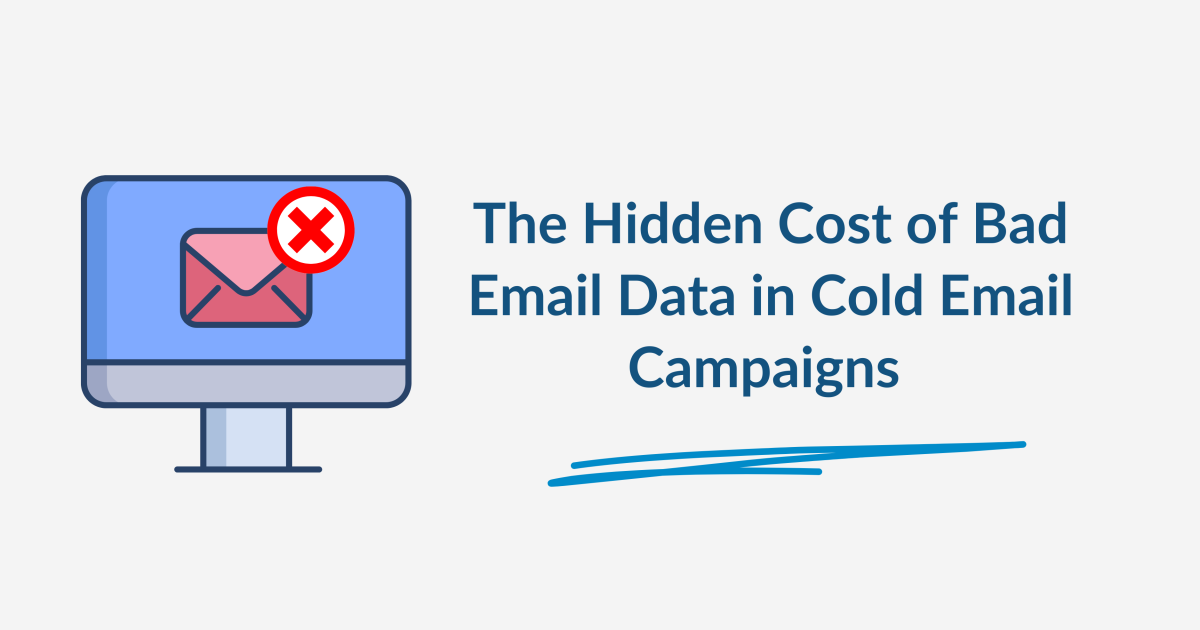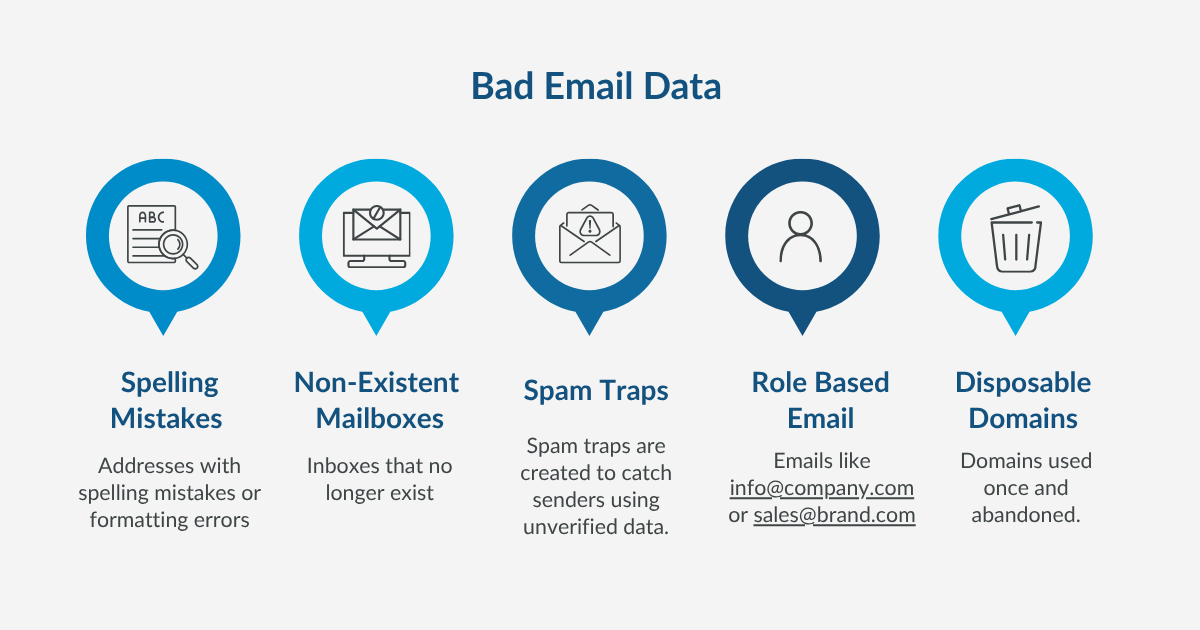
Author: MailClickConvert Team
Last Updated: November 6, 2025
Why your email data matters more than you think
Cold email is still one of the most effective ways to start B2B conversations, but it doesn’t just depend on good writing or automation tools. It begins long before you click “send.”
The quality of your contact data determines whether your message ever gets seen.
Every database, no matter how carefully built, collects bad addresses over time. When these bad emails slip into your outreach, delivery rates fall, and analytics lose reliability. Campaigns that once brought in leads suddenly cost more and convert less.
For many marketers, the real reason isn’t the strategy or the offer. It’s the data.
In this guide, we’ll look at what bad email data does behind the scenes, how it affects your sender’s reputation, and the simple steps that keep your campaigns performing at their best.
What makes email data “bad”
Email data doesn’t go bad quickly, it happens gradually. Each time someone changes jobs, closes a business, or abandons an inbox, that address becomes a dead end.
Other times, the issue starts at the source. Lists purchased from low-quality vendors, sourced from public websites, or merged from outdated databases often include errors and traps.

Common examples include:
- Addresses with spelling mistakes or formatting errors
- Inboxes that no longer exist
- Spam traps created to catch senders using unverified data
- Role-based emails like info@company.com or sales@brand.com
- Disposable domains used once and abandoned
These addresses might look harmless. But when sent in bulk, they quietly undermine your deliverability and reputation.
If you’ve ever bought or considered buying an email list, read our guide first: A Complete Guide to Purchased Email Lists
How bad data damages deliverability and performance
The issue with poor-quality data goes beyond wasted sends; it affects every part of your outreach.
- Unreliable results
If many of the email addresses on your list don’t exist or belong to inactive accounts, your numbers stop showing the truth. You might assume a weak subject line caused low open rates when your emails never reached an inbox.
Because of that, it has become hard to know what to improve. You end up changing words, timing, or offers while the real problem, dirty data, remains unsolved.
- Higher sending costs
Every time you send a contact that doesn’t exist, you still pay for it. Those messages count toward your sending limit or your plan’s monthly quota. They also take up time and system space that could have been used for valid prospects.
It’s like mailing hundreds of letters to empty houses. You spend effort and money, but nothing ever comes back.
- Lower sender reputation
Email service providers like Gmail and Outlook keep their score on how clean and responsible each sender is. If your emails bounce too often or hit spam traps, they see it as careless sending. Over time, your domain gains a poor reputation.
Once that happens, even your best-written emails may start landing in spam. Rebuilding trust takes patience and consistent good sending habits.
- Weaker engagement signals
Email algorithms track engagement (opens, clicks, and replies) to determine message relevance. Fake or inactive contacts drag these numbers down, signaling that your emails are being ignored.
The result: your messages get deprioritized or sent straight to spam.
(For a closer look at deliverability metrics, visit Google Postmaster Tools)
Why does good data go bad faster than expected?
Email databases age quickly. In B2B markets, turnover is constant. Even the most legitimate data sources lose accuracy over time.
Research from marketing platforms shows that business email lists decay by roughly 20 to 25% each year. If your CRM holds 10,000 contacts today, about 2,000 may be outdated within a year.
The issue grows faster when you rely on purchased or third-party lists. Many of these providers don’t share how often their data is verified or where it originally came from. By the time it reaches your system, a large percentage may already be inactive or recycled.
The business impact beyond deliverability
Poor data quality doesn’t just affect delivery; it distorts decision-making. Teams build campaigns around misleading engagement signals.
A low open rate might be blamed on weak copy when 30% of the list never received the message.Sales teams waste time following up on dead leads. Budgets go toward unreachable
Even worse, damaged sender reputation can delay messages to active prospects, causing lost revenue opportunities you never realize.
Bad data doesn’t just slow campaigns; it clouds your visibility. You end up optimizing results that don’t reflect real behavior.
How do you maintain clean email list data?
Maintaining data quality isn’t a one-time project. It’s a cycle of validation and review that runs alongside every campaign.
A healthy process includes:
- Check out new lists before you use them.
Always verify new contacts before adding them to your system. Even a small batch of unverified emails can cause high bounce rates and lower your domain’s trust.
Clean existing lists regularly. For frequent senders, once every three months is a good rule of thumb. Lists decay faster than most people think, and regular cleaning keeps these problems from piling up.
- Watch your bounce and open rates closely.
If your bounce rate starts rising or your opens drop suddenly, it’s usually a sign that your list has gone stale. Running a quick check before your next campaign can fix it before it spreads.
- Filter out problem addresses early.
Remove risky addresses like role-based or disposable emails to avoid spam complaints and maintain healthy engagement.
- Separate active and inactive contacts.
Keep your most engaged recipients in their own segment. When you notice people who haven’t opened in a long time, stop sending them until you confirm they still want your emails.
Following these steps ensures that your reports reflect reality: real people opening and responding to real emails.
Related Reading: Read a step-by-step guide here on how to improve your email deliverability
Where automation fits in
Manually managing data health across thousands of contacts is almost impossible.
This is where automated cleaning and verification tools can make a measurable difference.
MailClickConvert checks each uploaded list against a live database of known bounces and complaint addresses, removing invalid or risky contacts before you send.
For senders who want deeper verification, MCC also checks emails directly at the server level, confirming whether an inbox actually exists.
Beyond cleaning, the system tracks bounce over time and suppresses those addresses from future sends, keeping your data consistently healthy without manual effort.
What strong data practices mean long term
When your contact list is clean, every part of your email process improves. Higher engagement builds sender trust, which further boosts deliverability.
Businesses that make data maintenance part of their cold email routine grow faster because they learn from reliable results. Each campaign teaches them something new based on real interactions instead of faulty data. Over time, those small improvements turn into big performance gains.
With inboxes getting more crowded every year, keeping your data accurate isn’t just about avoiding problems, it’s a strategic advantage.
Want to see how clean data improves inbox placement? Read The Role of List Cleaning in Cold Email Success.
Final thoughts
Cold email remains one of the easiest ways to reach new business opportunities. But success starts with clean data.
If you haven’t reviewed your list in a while, now’s a good time. Run a quick verification before your next send and see what difference accurate data makes. A few minutes of cleaning today can save you weeks of poor results later and help your next campaign reach the people who actually want to hear from you.
Check your next list with MailClickConvert and see how clean data transforms your results.
- Log in to post comments

